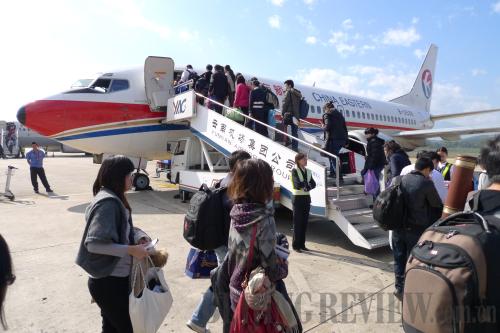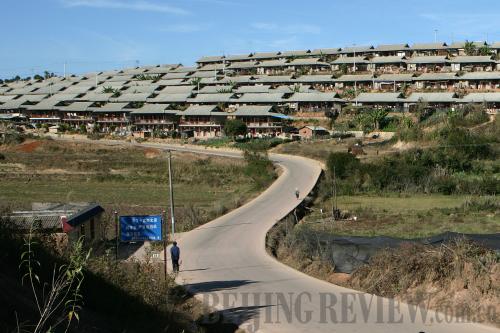|
 |
|
FREQUENT FLIERS: Passengers queue to board an aircraft at Kunming Wujiaba Airport. The airport has seen renewed growth in recent years as part of the Western Development Strategy (WANG XIANG) |
 |
|
ROAD TO PROSPERITY: A cement-paved road links Longlong Village in Yunnan Province to the outside world (WANG XIANG) |
Kunming Wujiaba Airport in southwest China's Yunnan Province is no strange name to veterans and enthusiasts of the Flying Tigers, the famed volunteer force of U.S. pilots who fought in China at the start of World War II. At its peak, two planes took off or landed at the airport every minute.
After World War II, Wujiaba Airport's fame declined and all but disappeared. Although business improved slightly after the founding of the People's Republic of China in 1949, the airport failed to regain its former glory until 2001.
Ni Hong, a Yunnan civil aviation official, said that a number of reforms to Yunnan's civil aviation sector have been implemented since 2001, allowing Kunming Wujiaba Airport to rise in rank to the seventh largest airport in China in terms of passenger turnover in 2005.
Currently, the airport is unable to meet transportation needs for air carriers—many flights are forced to hover over the airport prior to their scheduled landing. The Kunming Municipal Government is investing 23.4 billion yuan ($3.43 billion) toward the construction of a new airport to ease pressures on Wujiaba Airport, while the latter is undergoing a capacity expansion project expected to be completed by 2012, Ni said.
Kunming Wujiaba Airport is just one of the many success stories owing to the rapid development across China's west in the past decade.
The Western Development endeavor covers Chongqing Municipality, Sichuan, Guizhou, Yunnan, Shaanxi, Guansu and Qinghai provinces, and Tibet, Ningxia Hui, Xinjiang Uygur, Inner Mongolia and Guangxi Zhuang autonomous regions. The campaign benefits more than 70 percent of the country's total territory, and about 30 percent of its total population.
The per-capita GDP in the region stood at about 60 percent of the national average, 40 percent of the eastern average in 1999. In addition, the majority of China's then 50 million impoverished population, who earned less than 786 yuan ($115.1) a year, were living in this region, making it a major obstacle in China's march toward an all-around well-off society.
In order to narrow the gap between the rich east and less developed west, the Chinese Government officially launched the strategy of developing west China in November 1999. The Central Government clarified the strategy's guidelines, tasks and policies in January 2000, marking the beginning of the decade-long efforts.
| 